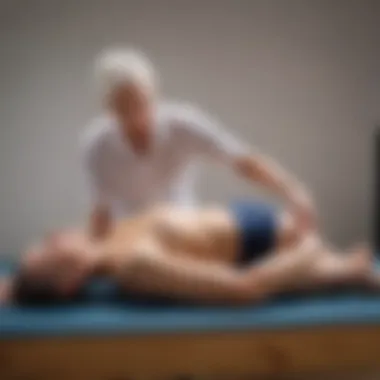Integrating Physical Therapy with the Feldenkrais Method


Intro
The integration of various therapeutic approaches has become increasingly important in healthcare. Each method brings unique philosophy and techniques to the table. Among these, physical therapy and the Feldenkrais Method stand out. Both aim to enhance mobility and improve well-being, yet they take different paths to achieve similar outcomes. In this article, we will explore how these two disciplines intersect, revealing their potential benefits when used together.
In the following sections, we will define key concepts, delve into their methodologies, and analyze real-world applications. The ultimate goal is to provide insight into how combining physical therapy and the Feldenkrais Method can lead to enhanced patient care, offering practitioners new perspectives on treatment.
Prologue to Physical Therapy
Physical therapy is a crucial component of the healthcare system. It focuses on diagnosis, treatment, and management of individuals affected by injury, illness, or disability. The relevance of physical therapy in the context of this article cannot be overstated. It offers holistic benefits by restoring function and mobility, relieving pain, and improving overall quality of life for patients. As we explore its intersection with the Feldenkrais Method, it becomes clear that understanding physical therapy sets the stage for recognizing how these two disciplines can complement each other.
Definition and Scope
Physical therapy encompasses a range of practices and interventions aimed at enhancing physical function. It involves evaluating patients to develop comprehensive treatment plans that may include exercise, manual therapy, education, and modality use. The scope of physical therapy is broad, extending to various settings including hospitals, outpatient clinics, and home health environments. By addressing movement dysfunction and promoting health and wellness, physical therapy serves not only as a means of rehabilitation but also as a preventive measure for countless conditions.
History and Evolution
The history of physical therapy traces back to ancient civilizations, where massage and manual therapy were commonplace. In the early 20th century, the profession began to formalize in response to the needs of soldiers injured in World War I. The establishment of physical therapy schools and the formation of professional organizations highlighted its evolution. Over the decades, physical therapy has morphed into an evidence-based practice, integrating new research and methodologies to improve patient outcomes. Just as important, it acknowledges a patient-centered approach rooted in science and empathy.
Understanding the Feldenkrais Method
The Feldenkrais Method is a unique approach to movement education and rehabilitation. Its principles are deeply rooted in the understanding of how the human body functions. This method enhances awareness through movement, promoting a more profound understanding of one’s physical capabilities. This understanding is beneficial not only for rehabilitation purposes but also for overall well-being. In this article, we will explore these core principles and techniques to identify how they relate to physical therapy.
Core Principles of Feldenkrais
The Feldenkrais Method rests on several core principles that guide its practice. Firstly, the concept of awareness is paramount. Awareness is not merely seeing or sensing; it encompasses the integration of sensory feedback into one’s movement. By using thoughtful, slow movements, practitioners observe their body and notice patterns that may be causing discomfort or limitation.
Secondly, the importance of learning is emphasized. In contrast to traditional therapeutic practices that often focus only on healing, Feldenkrais sees injury as an opportunity for growth. Learning how to move differently can positively impact physical abilities and mental outlook. With a focus on self-discovery, individuals engage in their treatment and build confidence in their bodies.
Lastly, the notion of functional movement is significant. Instead of concentrating purely on strength or endurance, the Feldenkrais Method promotes efficient and coordinated movement. This understanding helps individuals perform daily tasks more effectively, which can improve overall quality of life.
Methodologies and Techniques
Feldenkrais employs various methodologies and techniques that adapt to individual needs. Two primary components are Awareness Through Movement and Functional Integration.
- Awareness Through Movement (ATM): This involves group classes where a teacher leads participants through gentle movement sequences. Each lesson is designed to increase awareness of body mechanics and facilitate easier movements. Participants often find their range of motion is enhanced, leading to reduced pain.
- Functional Integration (FI): This is a more personalized one-on-one approach. A practitioner uses gentle touch to guide a client's movement patterns. This technique helps to identify inefficiencies or habitual patterns that create movement challenges. The practitioner tailors the session to the client’s specific needs, facilitating a unique, path to recovery.
These methodologies not only aid rehabilitation but also enhance everyday functioning. They encourage a recalibration of how individuals relate to their own bodies. As the Feldenkrais Method integrates with physical therapy, it brings attention to movement quality, which can transform therapeutic outcomes.
“The Feldenkrais Method empowers individuals to discover their capabilities and limitations, fostering an environment where learning and growth are paramount.”
Theoretical Foundations of Physical Therapy
Theoretical foundations of physical therapy encompass the essential principles and concepts that guide practitioners in their approach to patient care. Understanding these foundations is crucial for both students and seasoned professionals. It provides a framework for analyzing various techniques and integrating them into treatment plans. This foundation validates the practices used in physical therapy and links theory to practical application.
Grounding in science enables practitioners to formulate effective treatment methods based on sound evidence. It also helps therapists to tailor interventions according to the physiological and psychological needs of their patients. This is especially relevant as we explore the integration of the Feldenkrais Method, which benefits from the robust theoretical underpinnings present in physical therapy.
Physiological Principles


Physiological principles are the backbone of physical therapy. They refer to how the human body functions in terms of movement, healing, and rehabilitation. Therapists must have a solid understanding of anatomy, biomechanics, and physiology to effectively address injuries and movement dysfunctions.
The principles include:
- Kinematics: Study of movement without considering the forces that cause the movement.
- Kinetics: Focus on the forces involved in movement.
- Muscle Function: Understanding how muscles work together to create movement is essential. This includes the roles of agonists, antagonists, and stabilizers.
- Postural Control: Assessing how posture affects movement and stability.
By applying these principles, therapists can develop targeted interventions that restore function and enhance mobility. Such insights are vital when considering the Feldenkrais Method, which also emphasizes awareness of body mechanics.
Psychological Aspects
The psychological aspects in physical therapy address the mental and emotional factors influencing a patient’s rehabilitation process. Recognizing how psychological health affects physical recovery is crucial for a holistic approach. This understanding can improve patient compliance and enhance outcomes.
Several elements of psychological aspects include:
- Patient Motivation: Encouraging patients to engage actively in their recovery process.
- Mind-Body Connection: Understanding how thoughts and feelings can impact physical performance.
- Coping Strategies: Helping patients develop strategies to deal with pain and disability.
- Emotional Support: Providing emotional encouragement and understanding during rehabilitation can foster better results.
Incorporating these psychological principles within physical therapy improves the overall effectiveness of treatments. As the Feldenkrais Method includes methods of enhancing self-awareness and body perception, integrating psychological aspects can encourage a more successful healing experience.
Theoretical Foundations of the Feldenkrais Method
The theoretical foundations of the Feldenkrais Method provide a critical framework to understand its interplay with physical therapy. This method emphasizes the significance of self-awareness and movement patterns, derived from concepts within neurological and educational sciences. Understanding these foundations allows practitioners to integrate the Feldenkrais Method into physical therapy practices effectively, potentially enhancing patient recovery and overall well-being.
Neurological Insights
Neurological insights form a cornerstone of the Feldenkrais Method. This approach recognizes that movement is not merely a physical act; it involves complex neural processes. The method centers on neuroplasticity, which refers to the brain's ability to reorganize itself by forming new neural connections. Through tailored movements and awareness, individuals can influence their neurological pathways.
This is particularly important for patients recovering from injuries or neurological disorders. By focusing on how they move, individuals can identify and change detrimental patterns, promoting healthier motion and enhancing recovery. Research indicates that engaging the brain in new movement experiences can lead to significant improvements in function and mobility. This integration of neurological principles into therapy showcases the method’s relevance in creating adaptive strategies for movement.
Educational Framework
The educational framework of the Feldenkrais Method invites a unique perspective on learning and improvement. It centers on experiential learning, encouraging individuals to explore movements without the pressure of traditional physical training. This environment fosters an atmosphere of curiosity and self-discovery, which is crucial in therapy.
Recognizing that everyone learns differently, the Feldenkrais Method utilizes various techniques to accommodate diverse learning preferences. For example, practitioners guide clients through explorative sessions that emphasize personal experience over rote execution of techniques. This process promotes intrinsic motivation, empowering individuals to take ownership of their recovery journey.
Additionally, the educational aspect enhances the therapist-client relationship. Practitioners can facilitate a deeper understanding between clients and their own movements, leading to improved self-efficacy. As clients become more aware of their body and its capabilities, they often develop a greater sense of agency in their rehabilitation process.
In summary, the theoretical foundations of the Feldenkrais Method establish a robust platform for understanding its role in enhancing physical therapy. Neurological insights inform the method’s approach to movement, while the educational framework supports personalized learning experiences for individuals in therapy, ultimately driving successful outcomes.
Comparative Analysis
The Comparative Analysis section plays a crucial role in understanding the intersection of physical therapy and the Feldenkrais Method. This analysis allows for a thorough examination of their respective objectives, methodologies, and effectiveness in patient care. By articulating the similarities and differences between these approaches, practitioners can glean valuable insights that can lead to enhanced practices in rehabilitation and movement education. A comprehensive analysis is essential for identifying areas of potential integration and mutual enrichment, ultimately benefiting patient outcomes in therapeutic settings.
Similarities in Goals
Both physical therapy and the Feldenkrais Method share a common focus on improving patient well-being and functionality. The primary goals can be summarized as follows:
- Enhancement of Movement: Both disciplines aim to restore or enhance the ability of individuals to perform daily activities. This objective is fundamental in both methods, addressing mobility issues and functional limitations.
- Pain Reduction: Alleviating pain is a shared priority. Whether through targeted exercises in physical therapy or through awareness and movement adjustments in Feldenkrais, the intent is to help patients experience less discomfort.
- Promotion of Self-Awareness: Both approaches emphasize the importance of body awareness. Physical therapy educates patients about proper movement patterns, while the Feldenkrais Method cultivates a deeper understanding of personal movement habits.


Despite differing methods, the focus on these goals underscores a commitment to improving quality of life and function in individuals.
Differences in Approach
While both physical therapy and the Feldenkrais Method aim for similar outcomes, their approaches diverge significantly:
- Methodology: Physical therapy often employs a structured regimen involving exercises and interventions tailored to address specific injuries or dysfunctions. Conversely, the Feldenkrais Method is less prescriptive, prioritizing exploration and self-discovery through gentle movement and awareness within a non-linear framework.
- Therapist's Role: In physical therapy, the therapist typically takes an active role in guiding the patient through specific tasks and exercises. In contrast, Feldenkrais practitioners act more as facilitators, encouraging patients to engage with their own movement processes freely.
- Focus on Mechanics vs. Awareness: Traditional physical therapy emphasizes correcting movement mechanics, while the Feldenkrais Method prioritizes enhancing overall awareness and understanding of the body's movements. This leads to a more holistic approach that considers emotional and cognitive factors in addition to the physical aspects.
A comprehensive understanding of the similarities and differences between these approaches can pave the way for more enriched and integrative practices in patient care. Insights gained from comparative analysis are foundational for advancing therapeutic techniques.
Integration of Feldenkrais in Physical Therapy
The integration of Feldenkrais in physical therapy represents a progressive approach to patient care, emphasizing a holistic understanding of movement and rehabilitation. This incorporation is crucial as it highlights broader strategies for enhancing physical capabilities and improving overall quality of life. Both disciplines share a fundamental goal: to help individuals regain or enhance their movements and function. Yet, they traverse distinct paths to achieve this purpose.
Incorporating Feldenkrais techniques into physical therapy practices can provide numerous benefits. The Feldenkrais Method enhances patients' awareness of their body, promotes mindfulness, and encourages self-discovery through movement. Unlike traditional physical therapy, which often focuses on specific therapeutic exercises, the Feldenkrais Method encourages the exploration of new movement patterns. This experience aids patients in understanding their physical limitations and capabilities better.
Here are key elements that underscore the significance of this integration:
- Enhanced Awareness: Encouraging self-awareness allows patients to recognize habitual patterns that may contribute to pain or restricted movement.
- Adaptive Learning: Through exploration, patients can learn how to adjust their movements for greater efficiency and comfort.
- Complementary Techniques: The focus on function and awareness in Feldenkrais aligns with physical therapy’s rehabilitative goals.
Despite the apparent compatibility, the integration of these practices does not come without challenges. Physical therapists must be trained in Feldenkrais principles to ensure effective application. Additionally, there is a need for a substantial body of research demonstrating the efficacy of these combined methods. Nonetheless, this integration offers exciting possibilities for enriching patient care and customizing rehabilitation strategies.
Practical Applications of Feldenkrais in Clinical Settings
The integration of the Feldenkrais Method into clinical settings opens up new avenues for patient care, emphasizing the need for customized therapies. This method offers a unique perspective that both complements and enhances traditional physical therapy practices. By honing in on the specific needs of individuals, healthcare professionals can better facilitate recovery, promote movement, and reduce discomfort. In clinical settings, practical applications of Feldenkrais help to bridge the gap between psychological and physical aspects of rehabilitation.
Feldenkrais Techniques for Pain Management
Feldenkrais techniques play a vital role in pain management, and they take a multifaceted approach to address discomfort. Key strategies include awareness through movement and functional integration. Through awareness, patients develop a deeper understanding of their own bodies. This self-awareness often leads to a more effective management of pain.
- Awareness Through Movement involves guided exercises, which help patients discover alternative movement patterns. For instance, if a patient has chronic back pain, they may learn how to shift their weight more efficiently to reduce strain.
- Functional Integration helps the practitioner to work hands-on with the patient, allowing for improved alignment and coordination. The practitioner gently guides the patient’s movements, promoting ease and comfort, which can lead to reduced pain.
By employing these techniques, practitioners can empower patients to take control over their physical discomfort, reducing reliance on medications and fostering a more holistic approach to health.
Enhancing Movement Efficiency
Enhancing movement efficiency is central to the Feldenkrais Method. This aspect is particularly important in therapeutic settings where physical limitations are present. The focus is on optimizing how individuals move through everyday tasks, reinforcing the concept that movement should be both purposeful and natural.
In practice, this can be achieved through activities that promote:
- Rethinking movement patterns: Patients are encouraged to examine and modify how they perform daily activities, such as walking, reaching, or lifting. This encourages adaptive behaviors that can alleviate undue stress on joints and muscles.
- Increasing flexibility and strength: Exercises are tailored to improve overall strength and flexibility without causing strain. This tailored approach enables patients to regain confidence in their mobility.
- Developing coordination: Improved coordination through organized movement can significantly enhance a patient’s daily functioning. For instance, coordination-enhancing exercises can be pivotal for elderly patients at risk of falls.
"Movement quality often determines the level of comfort and efficiency in every action we perform."
By focusing on these elements, Feldenkrais can lead to more functional and self-sufficient movements, thereby elevating the overall quality of life for patients. Its practical application in clinical settings shows promise not only in immediate physical recovery but also in long-term well-being.
Challenges and Criticisms


The integration of the Feldenkrais Method into traditional physical therapy is not without its challenges and criticisms. Understanding these uncertainties is essential in evaluating the efficacy and relevance of both therapeutic approaches. The medical community, in particular, expresses skepticism regarding the scientific basis of the Feldenkrais Method. Such skepticism often stems from the method's theoretical foundations, which some professionals deem less rigorous than conventional medical practices.
Consideration of challenges is vital as it shapes the acceptance and application of the Feldenkrais Method in mainstream therapy. Addressing these criticisms can lead to stronger frameworks and methodologies that benefit patient outcomes and professional practice.
Skepticism in the Medical Community
Many healthcare practitioners are hesitant to embrace the Feldenkrais Method. This skepticism primarily arises from the method's subjective assessments of movement and awareness. Some professionals argue that the lack of standardized measures undermines its credibility. The emphasis on self-awareness and personal experience contrasts with the objective measurements often sought in physical therapy. This divergence raises questions about the method's scientific validity. Moreover, since clinical outcomes are difficult to quantify, it becomes a challenge for practitioners to justify its integration into established therapy practices.
Additionally, some research suggests that while patients may report improvements in their quality of life or pain levels, these changes are often anecdotal. The perception of Feldenkrais as a more philosophical approach to movement can further alienate some professionals. This critique calls for more rigorous scientific research to validate its methods, thus enhancing trust within the medical community.
Limitations in Research
Research on the Feldenkrais Method is often characterized by its inconsistency. There is a notable lack of large-scale, randomized controlled trials that adhere to modern research standards. Many studies suffer from small sample sizes or methodological flaws, hampering generalizability. While some clinical trials indicate positive outcomes related to pain management and movement efficiency, they often do not provide robust data to support widespread adoption.
Furthermore, the diverse applications of the Feldenkrais Method yield variable results that complicate research efforts. For example, different practitioners may use varying techniques and principles within their sessions. This inconsistency poses a challenge for researchers trying to isolate specific elements contributing to efficacy.
The existing literature may also struggle with publication biases, where positive outcomes are more likely to be published than studies showing no significant effects. To foster broader acceptance, future research endeavors should prioritize larger, well-structured studies encompassing diverse populations and clinical scenarios. This approach can help clarify the efficacy of the Feldenkrais Method and its potential role in holistic therapeutic practices.
"The legitimacy of the Feldenkrais Method hinges on the future research that can validate its practice within the realm of physical therapy."
Future Directions in Therapy Practices
As the landscape of healthcare continues to evolve, the intersection of physical therapy and the Feldenkrais Method becomes increasingly relevant. Understanding future directions in therapy practices is crucial for various stakeholders including practitioners, researchers, and educators. This section highlights emerging elements, benefits, and considerations that shape the future of integrative therapeutic approaches.
Emerging Trends in Integrative Therapy
Integrative therapy is gaining traction in contemporary health practices. This approach emphasizes patient-centered care that combines multiple methods for improved outcomes. There are several trends currently shaping this discipline:
- Holistic Focus: Integrative therapy recognizes the whole person, encompassing physical, mental, and emotional well-being. This leads to a more comprehensive treatment plan.
- Collaborative Practices: Increasingly, healthcare professionals from various disciplines work together. Cross-training in physical therapy and the Feldenkrais Method allows practitioners to offer diverse treatment options, enhancing patient care.
- Telehealth Expansion: The rise of telehealth provides new avenues for therapy. Both physical therapy and Feldenkrais can be adapted for remote sessions, making it more accessible for patients.
These trends demonstrate a shift toward a more integrative approach, which can ultimately enhance patient treatment strategies.
Potential for Expansion in Rehabilitation Settings
The Feldenkrais Method offers unique contributions to rehabilitation settings. As more research supports its efficacy, there is a growing potential for its integration into traditional physical therapy practices:
- Customized Rehabilitation: The individualized nature of the Feldenkrais Method complements traditional therapies. Patients can benefit from tailored programs that address their specific needs and circumstances.
- Innovative Techniques: The use of movement awareness and re-education of the body's mechanics can facilitate recovery in ways conventional methods may overlook. This can lead to quicker healing processes and improved long-term outcomes.
- Evidence-based Research: As studies illustrate the positive impacts of integrating the Feldenkrais Method, there is an opportunity for its more widespread adoption in rehabilitation settings.
The synergy created by combining these practices can elevate the standards of patient care.
"Integrating the Feldenkrais Method into physical therapy practices can bridge gaps in treatment, offering diverse strategies for rehabilitation."
Closure
The exploration of the intersection of physical therapy and the Feldenkrais Method reveals significant insights into how these two domains can enhance patient care. Understanding this relationship can inform practitioners about new methodologies that can be integrated into existing practices. It showcases the adaptability of therapeutic techniques and the importance of a holistic approach in rehabilitation.
Summary of Key Insights
This discourse has highlighted several core aspects regarding the confluence of physical therapy and the Feldenkrais Method. Firstly, both practices aim to improve patient outcomes by enhancing mobility and reducing discomfort. Secondly, the Feldenkrais Method emphasizes self-awareness and movement efficiency, which can empower patients in their rehabilitation journey. Daily living improvements, emotional well-being, and functional autonomy arise as essential outcomes of these integrative efforts. The respective strengths of these methods can complement each other, enhancing clinical efficacy.
Call for Further Research
There exists a pressing need for further research to substantiate the anecdotal evidence surrounding the integration of Feldenkrais with traditional physical therapy. Future studies should aim to establish clearer correlations between specific Feldenkrais techniques and improved patient outcomes. Evaluating the long-term benefits and potential challenges of this integration can lead to a greater understanding of its practical applications. Academic dialogue surrounding these topics is essential for developing standardized practices that can benefit a diverse patient population.
"The fusion of methodologies within physical therapy and the Feldenkrais Method not only broadens the horizon for therapeutic possibilities but also enhances the depth of practice."



